by Scott
Perkins
(click on photos to enlarge image)
THE STIEFF COMPANY: HISTORIC OVERVIEW
This article is an excerpt kindly allowed by the author.
For a more complete history and to view the silver of Stieff, please visit the site
THESTIEFFCOMPANY.COM
The Baltimore Sterling Silver Manufacturing Company was
started in 1892 by Charles Clinton Stieff and several partners.
Mr. Stieff was not a silversmith himself, but an entrepreneur
who dealt in silver and cutlery. The first pattern for the new
company was Maryland Rose. Other early silver patterns were
Victoria, Plain & Engraved and Chrysanthemum. (The names of Rose
and Maryland Rose were alternated by the company through the
1920's).
In the early years, the company would make silver for both its
own retail shop located at 17 North Liberty Street in downtown
Baltimore, and for other retailers whose name would be stamped
on the silver. This was an early form of what we could today
call "private label" branding. As the company's fine silver
products became better known around Baltimore, the company's
rather industrial sounding name was shortened to a more refined
"Baltimore Sterling Silver Company" and the silver mark became
BSSCo. The earliest examples of the company's silver are not
marked and it takes a trained eye to discern its origins. Many
early pieces carry the Crown and B mark.
The Stieff's Rose pattern
is very similar to the S. Kirk and Son pattern "Repoussť"
of 1828. Eighty-seven years later, Stieff would buy
Kirk. There is a section of this site that discusses
S. Kirk & Son.
The Great Baltimore fire of 1904 burned large parts
of downtown Baltimore but The Stieff building at 17
N. Liberty Street was not affected. The fire stopped
just a few doors down at the wall of 9 N. Liberty
Street, the location of The Stieff Piano Building,
saving that company. The Stieff Piano Co. was owned
by relatives.
The Stieff Company called its founder a "born
leader who left a legacy of positive actions for
American silver" He was a believer in the
enforcement of the laws requiring the marking of all
sterling silver as 925 or 92.5 to identify its
purity.
On the right the photos (from the Stieff Family
Collection) of Charles Clinton Stieff, Founder
and Laura Numsen Stieff (1897)
|

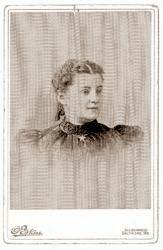
|
In 1904, Charles Stieff bought out his business partners and
the company name was changed from The Baltimore Sterling Silver
Company to The Stieff Company. Warerooms were located at 17
North Liberty Street until 1952. (Near the corner of Baltimore
Street and Liberty). Some materials show an address of 17 McLane
Place which was an attempt to rename some Baltimore streets
after the fire... the name change did not hold, and reverted to
Liberty several years later (Baltimore maps of 1914 show the
street name changed back to Liberty Street).

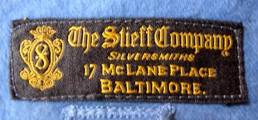
|
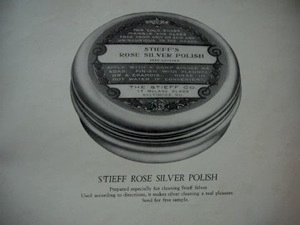
|
Cloth silver wraps from my
collection
showing the street name changes
|
Silver polish from the
McLane Place era
(Courtesy of Howard Lotti)
|
The manufacture of silver
first took place in Cider Avenue, a short street
that still exists today in Baltimore, and later at
311-323 West Redwood Street. The Redwood Street
location now has an office building on it that faces
the 100 block of Howard Street, across from the 1st
Mariner Arena Redwood, Cider Avenue (now Alley)
and the 17 Liberty Street address were all within a
couple blocks walk from each other. The Liberty
Street location is long gone, and the entrance to
the garage of a hotel occupies the space.
|
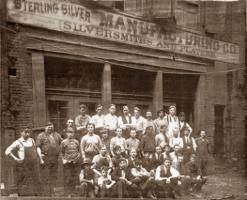
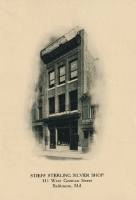
|
.
|
The Cider Alley Factory
with the Baltimore Sterling Silver Manufacturing Co.
Sign (The Balt. portion is cut off in the photo) and
the German Street factory location (the street was
later renamed Redwood Street)
|
On the evening of May 26, 1923, Stieff founder Charles C.
Stieff died at his desk at The Stieff Company's Redwood Street
offices. His son Gideon Stieff had become President of Stieff in
1914 and would continue to lead the company until 1970.
In April of 1925
manufacturing was moved to 800 Wyman Park Driveway
(note 1)
in the Hamden area of Baltimore. The location had
been selected by Claire von Marees for whom the Lady
Claire pattern was named. Ms. Marees and Gideon had
gone to Druid Park and were sitting up on a hill "spooning"
as it was called in the day. She pointed out to
Gideon that a particular location down below would
be a good location for the new factory that the
company was planning. Clair von Marees would become
Mrs. Gideon Stieff and live until 2003. Both she and
Gideon had grown up in the area.
(on the right) The new factory under
construction in 1924.
The writing on the photo says 1925 but since
manufacturing began in April 1925, this is incorrect.
Also incorrect is the spelling of STIEFF in the
upper right corner. The mill building in the
background still exists today.
|
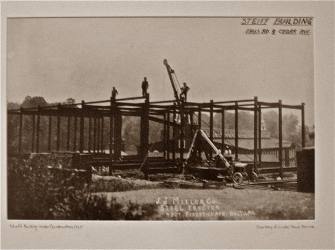
|
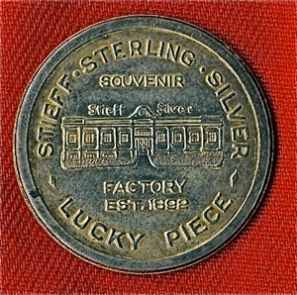
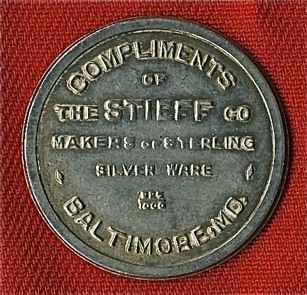
|
When the factory opened in
1925, Sterling Silver "Lucky Pieces" were given out
to people who toured the new building.
These are the size of a Fifty Cent Piece. These very
rare early pieces feature the one story building.
(This Lucky Piece was given to me by Charles C.
Stieff II.)
|

|
The Stieff Company
prospered for many years at Wyman Park Driveway.
While the new building had enough room for the present,
it had been designed structurally so that a
second floor could be added at a later date with out
disturbing the business below during construction.
Within five years, business had grown enough to add
the second floor. The building was doubled in size
in 1929 to 35,000 square feet.
The timing could not have been worse, as the stock
market fell and the great depression was just around
the corner. Not knowing how long the economic crisis
was going to last, Gideon Stieff kept the employees
busy painting and maintaining equipment, and
anything else that would keep them around. He knew
that once the skilled trades of the silver business
were laid off, that getting them all back when
business picked up would be near impossible. And as
business did start to pick up... war clouds were
forming over Europe.
|
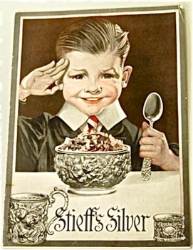
|
First Blank Stamped in New
Factory April 29th 1925. The pattern of this blank
is Rose (note 2)
|
.
|
A later 1920ís Stieff
Catalog (A young Charles C. Stieff II on the cover?)
|
In 1939 Stieff became the official maker of silver for the
Williamsburg Restoration in Williamsburg, Virginia. Actual
production did not take place until 1942 just in time to be
curtailed by the war effort. Stieff would also became the
suppliers of silver and pewter to The Smithsonian Institution,
Historic Newport, Mystic Seaport, Thomas Jefferson Foundation,
Old Sturbridge Village, and the Museum of Fine Arts in Boston
World War II would see
Stieff production move to the production of fine
surgical instruments for the United States Army and
components for radar equipment. Silver was
considered a vital war material and the government
took over control of silver supplies. Whatever
quantity that Stieff had on hand would have to last
them until after the war. Charles Stieff II said the
inventory was almost gone by 1943. Some small silver
items would continue to be produced throughout the
war, but in greatly reduced quantity.
|
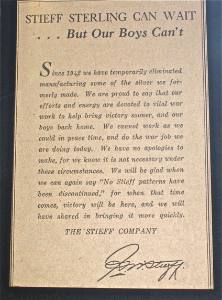
|
After the war, Charles C. Stieff II was the Vice President
of sales and traveled the country extensively to secure new
retailers for the company's products. By the later 1940's the
company's silver was being sold in over 400 stores around the
nation. Only those retailers that agreed to adhere to strict
quality controls were allowed to sell Stieff silver. By the
1960ís Stieff products would be in over 3000 stores nationwide.
In the 1950ís Stieff would make silver items for the Eisenhower
administration to give as gifts to dignitaries. Sometimes the
White House would send a helicopter over to The Stieff Company,
landing on the lawn of the factory, to pick up items. Stieff
also made flatware for use in the White House; some with the
presidential seal on it. Mamie Eisenhower toured the factory
and picked out silver items. When Charles C. Stieff III was born
in 1955, the first lady sent a personal hand written note to the
new baby, which he still has today as an adult.
Tastes change, as does fashion and the way we entertain. In the
prosperity after the second world war there was a brief golden
age of silver. Brides who had received their mothers silver
expanded the sets or decided on one of the new "modern" patterns
brought out by Stieff. As more women entered the workforce less
time was alloted for "teas" or formal entertaining. In the
1960ís silver sales started sinking fast. Casual dining and
stainless steel flatware gained popularity and acceptance. A
Silver Service was quickly becoming something that "your mother"
owned.
In 1967, The Stieff Company bought "The Schofield Company"
(note 3). The thought
was that by adding volume, more silver could be sold at a
lower price. Stieff would also gain the Schofield craftsmen.
Later all of the Schofield patterns would be discontinued.
Pewter was becoming more important to the company, and by the
early 1970's had become 60% of the company's sales. A 1971
expansion doubled the size of the Wyman Park Drive factory;
primarily for expansion of the pewter operations.
In the 1970ís the Hunt brothers of Texas tried to corner the
silver market. Prices fluctuated wildly making the silver
business unstable and unprofitable. When silver could be 50
dollars an ounce one month and 11 dollars an ounce the next
month, it became impossible to predict manufacturing cost or
price accurately. At both manufactures and retail stores it
became an impossible job to deliver goods at the price promised.
When silver prices were high, a lot of old silver was sold to
the scrappers to be melted down. We lost a lot of historic
silver during these dark days. The manipulation of the silver
market eventually bankrupted the Hunt brothers and resulted in a
10 million dollar fine from the government.
A major competitor, S. Kirk and Son was purchased in 1979.
Kirk had tried to diversify over the years as silver sales waned.
With limited success at diversifying, the company agreed to be
purchased by Stieff with the understanding that the Kirk
patterns would be continued. Many of the old Stieff patterns
were discontinued in December of 1979 to make room for the Kirk
patterns. The Kirk factory at 2225 Kirk Avenue in Baltimore was
closed and all operations were moved to the Wyman Park Drive
location of The Stieff Company. Again, the goal was added volume
to lower silver costs and the addition of skilled craftsmen. The
name was changed to Kirk-Stieff reflecting the 1815 start date
for Kirk against the 1892 date for Stieff. Kirk had been a
larger company with a larger market share. This extra presence
in the market place would be good for Kirk-Stieff ten years
later when Kirk-Stieff would be purchased by a larger company.
In 1990 the Lenox division of the Brown-Forman Corporation
bought Kirk-Stieff from the Stieff family. As Brown-Forman
struggled with digesting the various diverse companies it was
buying, the silver market was continuing to decline. Lenox was
in the tabletop business selling china, crystal, and flatware.
Brown-Forman also owned Hartmann luggage, and was heavily
invested in the liquor and spirits business.
The Stieff Factory ceased production on January 15, 1999 and the
building and retail outlet were shuttered on March 31st 1999. In
the end, only 75 employees remained in Baltimore to lose their
jobs at the time of closing. There had been 150 employees only
five years earlier. Production was moved to Smithfield, RI,
outside of Providence, RI into a building shared with Gorham, and
later to Pomona, New Jersey. Demand for sterling and hollow ware
had seen its heyday many years earlier.
The Stieff family retained ownership of the land and building at
800 Wyman Park Drive during the Lenox years, but later sold the
property after the factory closed. Struever Bros, Eccles & Rouse
purchased the building from the Stieffs. They specialize in
rehabbing historic buildings and the Stieff building is now
listed on the National Register of Historic Places. It is now a
mixed-use office building. The Stieff Silver sign has been
restored and continues to glow in the night sky.
Lenox would later be spun off into its own company with Kirk-Stieff
included within it. The product line expanded into gifts, glass
and outlet stores and the silver business soldiered on. Lenox
was bought by the "Dept. 56" gift company in 2005. Dept. 56 then
changed the name of the whole company to Lenox Brands. In July
2007, Lenox Brands sold the silver brands of Kirk-Stieff, Gorham,
Whiting and Durgin to Lifetime Brands, Inc. for 8.775 million
dollars (US). They currently manufacture and sell the product.
Lifetime Brands now produces sterling flatware in Puerto Rico.
|
I created the site THESTIEFFCOMPANY.COM after I was not able to find more than snippets of
information on Stieff silver. Some of the information available seemed to
contradict other sources. After a month or so of creating the site, I was
contacted by Charlie Stieff II with a few corrections of his own. With the
help of the Stieff family and a lot of research I have been able to
produce the site as a one stop source for silver collectors as well as
those looking to sell their silver on ebay.
Along the way, I have been able to properly identify the introduction
years for several patterns that have been incorrectly published over and
over in silver books. Another section hopefully puts an end to the old
rumor/urban legend that Frank Schofield created the dies for the first
Stieff pattern, Maryland Rose (aka Stieff Rose) and I have been able to
prove that this could not have happened. At the site, the 1939 catalog is
the best one to use to identify pieces of silver (both flatware and
hollowware) as it provided measurements of the various pieces and most of
the other catalogs shown on the site do not.
I invite you to visit the site where you will find hundreds of on-line
pages of Stieff Silver along with the pewter products the company created
later. I am always looking for additional material to add to the site,
especially ads, catalogs and price lists. If you have any material that
can be added, please contact me at Scottinelmgrove@yahoo.com
Scott Perkins
|
|
|
|
 ASSOCIATION OF SMALL COLLECTORS OF ANTIQUE SILVER
ASSOCIATION OF SMALL COLLECTORS OF ANTIQUE SILVER


















